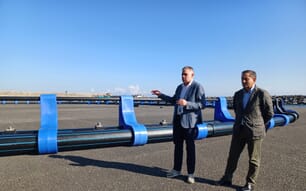It’s all in an effort to identify techniques for freeing non-target species from fishing nets. This is the sixth chapter of the ISSF Bycatch Project and it takes place onboard the Albatun Tres, a working Spanish vessel from the Albacora company fleet.
Most of the world’s tuna catch is made by purse seine vessels, which use a net to encircle and catch tuna. The Bycatch Project’s aim is to mitigate bycatch in the purse seine fishery, and is particularly focused on operations utilizing floating objects, called FADs.
In fishing, one of the main impacts on biodiversity is bycatch, the occurrence of incidental catches of non-target species made by commercial fishing vessels. Better-known examples of bycatch might include a boat unintentionally encircling a shark and trapping the animal in its net. In the Western Pacific, rates of shark bycatch in purse seine fisheries average between 0.9 tons per 1,000 tons of tuna caught for free-swimming schools (No FAD) and 1.1 tons per 1,000 tons of tuna caught for purse seine vessels fishing on FADs.
In order to identify new solutions, and build off of old ones, ISSF has led a series of research cruises since 2011. ISSF puts independent researchers and scientists out at sea on operational fishing vessels with an actual fishing crew in order to conduct research on potential strategies and techniques to reduce the occurrence of bycatch in real-world conditions. Using knowledge gathered from past research on the behavior of fish, scientists are developing methods that could help fishers avoid taking vulnerable species such as sharks
Information gathered during these cruises is not only incorporated into new protocols, proposed equipment modifications, and best practices guides, it is also passed along to vessel owners and skippers during workshops being held by ISSF in every tuna-fishing region of the world so that we can share the good lessons learned, from one side of the planet to the other.
The Crew
As with past bycatch cruises, scientists onboard will live amongst and work with the actual crew, while making sure to keep disruptions to the vessel’s fishing operations at a minimum.
Scientists on board will be Fabien Forget and John Filmalter, PhD Students from Mauritius and South Africa respectively, studying with the Institute of Research for the Development (IRD, France) and the South African Institute for Aquatic Biodiversity (SAIAB, South Africa), who have both been working on bycatch in the tuna purse seine fishery for several years. The lead scientist is Igor Sancristobal, a senior researcher at respected Spanish R&D firm Azti Tecnalia, who will oversee the cruise. Also from Azti Tecnalia, Guillermo Boyra, a senior researcher and expert on acoustics, will join the other scientists.
Although being at sea for weeks on end presents its share of challenges, all four scientists have spent their entire lives by the ocean; fishing, tagging, diving, snorkeling and eventually studying the oceans so they each have a very special relationship with the water and a respect for the life below it.
“Albacora is thrilled to provide the Albatun Tres and support such an important science-based initiative. We are committed to creating a more sustainable ocean environment and commend ISSF’s efforts in leading the charge,” said Imanol Loinaz, Fleet Director, Albacora S.A.
The Science
The cruise will focus on three main points: the passive mitigation of bycatch; avoiding catch before setting; and release from the net.
The passive mitigation of bycatch portion of the cruise involves estimating species and size composition of the fish aggregation around FADs through the use of echo-sounder buoys. The objective is to inform fishers on the composition of aggregations at FADs, e.g. target and non target species.
Avoiding catch before setting will consist in using a high quality scientific acoustic equipment, helping the scientists (and crew) determine the makeup of aggregation when the vessel is at the FAD. The aim for the fishing crew is to determine if the aggregation does not have too many small bigeye and yellowfin tunas before setting the net.
The testing of an escape panel to remove sharks and other bycatch from the net once it is set will also be undertaken. In addition, scientists will collect observational information on the behavior of the different species of tunas and bycatch inside the net to enhance the design of the escape panel and aid in the development of additional practical modifications to prevent bycatch being brought aboard.
Assessing the survival rate of large species such as whale sharks and manta rays that are sometimes caught in the net will be the final focal area. Animals will be handled following previously identified best practices and fitted with satellite tags to monitor their behavior and movements after they are released back into the Pacific. In this way further improvements can be adopted where necessary to improve the chance of survival.
Part of a Bigger Conservation Strategy
“Initiatives that put scientists on the water working in a collaborative way with experienced fishers, in real-world fishing conditions can advance our understanding of what works and what doesn’t. And, it can lead to new ideas to test on future cruises. Results from these cruises are then presented to other scientists and are used as the foundation for our skipper workshops across the globe,” said Susan Jackson, President, ISSF.
ISSF’s strategic plan focuses on fishery performance improvement through support of initiatives and science-based approaches to help fisheries reach a point where they would be able to meet the standards for Marine Stewardship Council (MSC) certification, without conditions. To get there, ISSF works to address core issues, like bycatch and FADs, which will directly improve tuna fisheries. In addition to facilitating scientific exploration in the area of bycatch, ISSF continues to reach out and share best practices with fishing fleets. Findings of the Bycatch Project inform best practices workshops and guidebooks.




